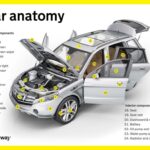Regular car maintenance, like oil changes and tire rotations, often includes a multi-point inspection by your mechanic. While it’s easy to trust their expertise when they point out something amiss under the hood, wouldn’t it be empowering to understand what you’re looking at yourself?
Whether you’re facing a roadside emergency or simply want to grasp how your vehicle operates, having a basic understanding of the components nestled under your car’s hood is incredibly valuable. Consider this your beginner-friendly guide to car parts under the hood, brought to you by carparteu.com, your trusted resource for automotive knowledge.
The Engine: The Heart of Your Vehicle
Let’s begin with the most crucial component – the engine. This is the powerhouse that converts fuel into motion, propelling your car forward. Often the largest and most centrally located part under the hood, the engine is truly the heart of your automobile. For detailed information specific to your engine model, always refer to your car’s owner’s manual.
Alternator: Keeping the Power Flowing
If your car struggles to start, the culprit could be either the battery or the alternator. The alternator, resembling a grooved pulley wheel, is responsible for generating electrical power while the engine is running. This power not only operates your car’s electrical systems but also recharges the battery, ensuring a continuous cycle of power.
Battery: The Initial Spark
The battery is usually easily identifiable as a rectangular box, often located in a corner of the engine compartment. It features distinct positive (red) and negative (black) terminals. The battery provides the initial electrical energy to start the engine and powers electrical components when the engine is off.
Belts: Driving Engine Accessories
Belts are essential for powering various engine accessories like the alternator, air conditioner compressor, and power steering pump. Many modern cars utilize a single serpentine belt, a long, ribbed belt that snakes around multiple pulleys, efficiently driving these components.
Cylinders and Spark Plug Wires: Where Power is Born
Engines contain cylinders, the chambers where fuel combustion generates power. Most vehicles have four, six, or eight cylinders. Each cylinder is typically paired with a spark plug, connected by spark plug wires, which ignites the fuel-air mixture to initiate combustion.
Pistons and Crankshaft: Converting Combustion to Motion
Pistons reside within the cylinders and move up and down in response to combustion. This linear motion is transferred to the crankshaft, a rotating shaft that converts the piston’s up-and-down movement into rotational energy. This rotational energy is what ultimately drives the wheels of your car.
Oil Fill Cap and Dipstick: Essential for Engine Lubrication
The oil fill cap, usually located on top of the engine and marked with “oil fill” or an oil can symbol, is where you add engine oil. The dipstick, also nearby, is used to check the engine oil level, ensuring it remains between the minimum and maximum marks for optimal engine lubrication and health.
Radiator: Managing Engine Heat
The radiator is a large, flat panel typically positioned behind the front grille of your car. It acts as a heat exchanger, dissipating heat from the engine coolant to prevent overheating. Important safety tip: Never open the radiator cap when the engine is hot, as the cooling system is under high pressure and can cause severe burns.
Transmission: Shifting Gears and Power
The transmission is located towards the rear of the engine, often hidden beneath other components. It’s responsible for transferring power from the engine to the wheels and allowing the car to operate at different speeds and loads. A transmission dipstick, usually located near the transmission, allows you to check the transmission fluid level.
Reservoirs: Holding Essential Fluids
Brake Fluid Reservoir: For Safe Stopping
The brake fluid reservoir, usually transparent for easy level checks, is located under the hood in front of the steering wheel. Maintaining the correct brake fluid level is crucial for a responsive and safe braking system.
Coolant Reservoir: Preventing Overheating
Located near the radiator, the coolant reservoir is typically made of translucent white plastic and holds the engine coolant. Proper coolant levels are vital to prevent engine overheating and potential damage.
Power Steering Fluid Reservoir: For Effortless Steering
The power steering fluid reservoir, often found on either side of the engine bay, may have a dipstick attached to its cap. Power steering fluid ensures smooth and easy steering. If you experience increased steering effort, check the fluid level.
Windshield Washer Fluid Reservoir: Maintaining Visibility
The windshield washer fluid reservoir, often blue with a windshield or droplet symbol on the cap, is usually easily accessible for refills. Keeping this reservoir topped up is essential for maintaining clear visibility while driving.
Carparteu.com: Your Partner in Automotive Understanding
Understanding the car parts under the hood empowers you as a car owner. It allows for better communication with mechanics, helps in diagnosing minor issues, and promotes a deeper appreciation for your vehicle. At carparteu.com, we are dedicated to providing you with the knowledge and resources you need to confidently navigate the world of cars. Explore our site for more in-depth guides, maintenance tips, and expert advice to keep your vehicle running smoothly and safely.
